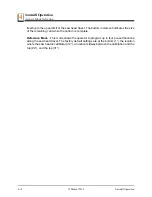
Sawmill Operation
Optional Cutting Procedure
Sawmill Operation
WMdoc072919
4-29
4
20.
Ensure that the flat on the log is placed
flat
against side supports (if turned 90 degrees) or
flat
on bed rails (if turned 180 degrees).
21.
Raise the front or rear toe board to align the log heart parallel with the bed, if necessary.
22.
Repeat the steps used to cut the first side of the log until the log is square. Cut boards
from the remaining cant by adjusting the blade height for the thickness of boards that you
want.
4.16 Optional Cutting Procedure
In order to achieve maximum production rates, it may be desirable to leave the blade
engaged when returning the carriage. (Normal operation procedures recommend disen-
gaging the blade before returning the carriage for maximum blade life and fuel economy.)
DANGER!
If leaving the blade engaged for maximum production rates,
ensure that the off-bearer stays out of the path of the blade. Failure to
follow this will result in serious injury or death.
CAUTION!
If you choose to leave the blade engaged; raise the blade
to clear the log before returning the carriage. Failure to follow this may
cause damage to the blade and/or sawmill.
4.17 Edging
1.
Raise the side supports to 1/2 the height of the flitches, or the boards that need to be
edged.
2.
Stack the flitches on edge against the side supports.
3.
Clamp the flitches against the side supports halfway up the flitch height.
NOTE:
Wider flitches should be placed to the clamp side. When they
are edged, flip them over to edge the second side without disturbing
the other flitches or without having to pull them from the middle of the
stack.
4.
Adjust the blade height to edge a few of the widest boards.
5.
Loosen the clamp and turn the edged boards over to edge the other side.
6.
Repeat steps 2-4.
7.
Loosen the clamp and remove the boards that have good clean edges on both sides.
















































